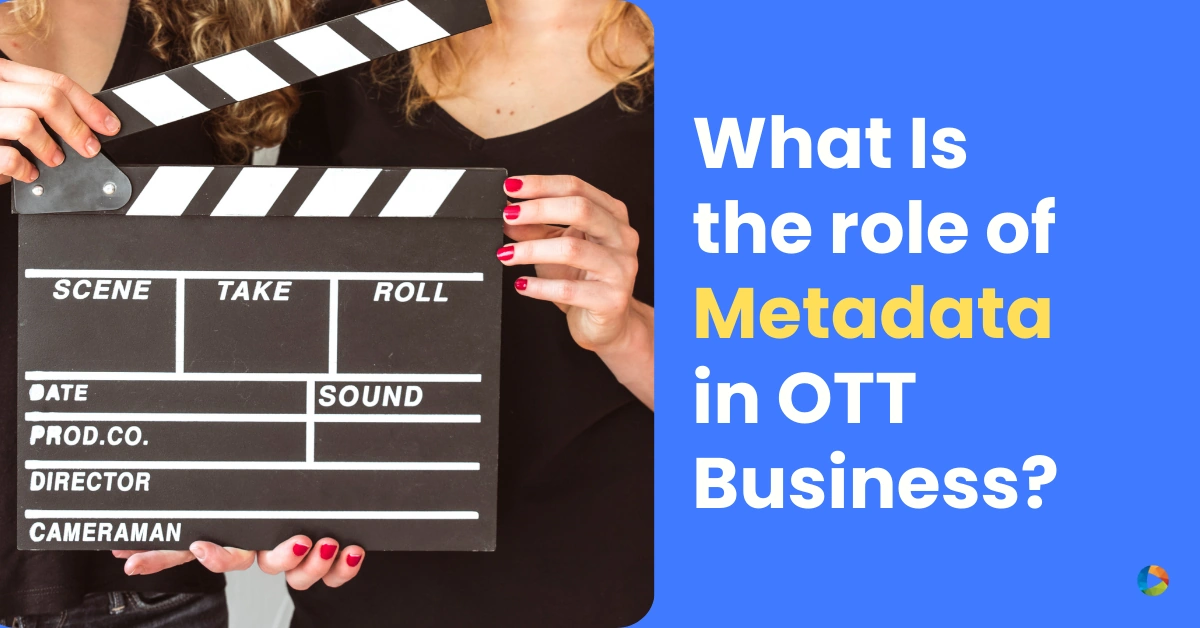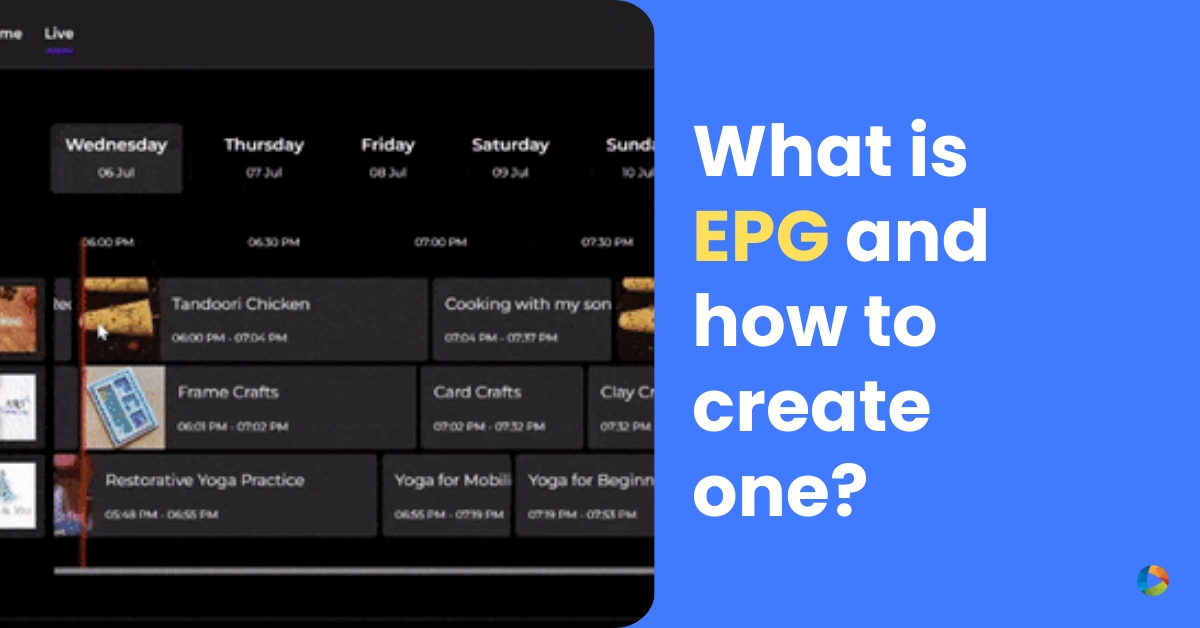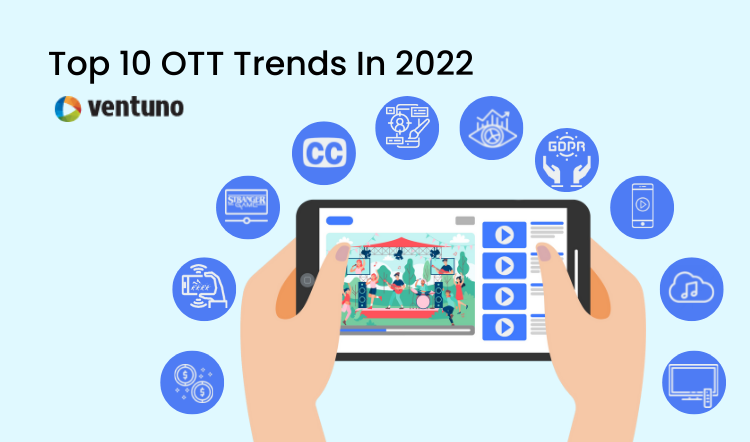What Is Metadata And What Role Does it Play In The OTT Business?
Last Updated on May 20, 2025 by Anjana Devi
Video content is winning the game across platforms. Be it 15-30 second reels on Instagram, YouTube shorts or long-form content on OTT platforms, video content consumption on the internet has grown massively over the years.
But there is a newly emerging problem appearing with too much video content being created, especially on OTT platforms and regular Pay TV. The challenge is about how to keep users engaged and increase user retention on these platforms. Metadata plays an important role here.
According to a report, nearly 73% of users are either extremely or somewhat frustrated when they cannot find enjoyable content. Two-thirds of respondents of the survey said that they would renew their subscription or upgrade their plan if the service provider offers better search or recommendations of content on their platform.
Metadata enables ease of navigation and content discovery, and provides high-quality recommendations to users. As an important OTT engagement strategy, metadata plays a key role in increasing the engagement and satisfaction level of users towards the OTT platform.
Let us now understand metadata in much more depth and know its importance for OTT users and businesses.
What is Metadata?
Simply put, metadata can be defined as data about the data. It is the information that is not prevalent to the user but performs important tasks from the back end in terms of quality content being recommended to users.
The key role that OTT metadata performs is to collect information about user behavior and store it for future reference. This allows the machine learning technology of the OTT platforms to improve its recommendations based on user preferences.
User behavior and preferences are an ever-evolving preferential and subjective matter. For the platforms to keep up with it, they will need to ensure that they are constantly monitoring these changes in user preferences and behavior.
Video streaming and OTT platforms also need to ensure that they have the right tools in place to understand these patterns, one of which is metadata.
Metadata Analogy
To break down the meaning of OTT metadata, let us compare it with a book.
Every book has an index page with titles of chapters and page numbers written against them in the beginning. This helps readers to easily go through the book. Readers know exactly on which page a particular chapter starts.
Similarly, content metadata enables better search, content discovery, and organization of data for users and enables users to navigate through the content easily.
Another analogy that can be used for metadata is the packaging.
An item is packed with some wrapping and then put in a box and goes through various ports, and means of transportation before it finally reaches its intended destination.
Contextual metadata also does the same. It goes through various user-centric data points and metadata is hidden or not too prevalent to the user, kind of like the wrap used in packaging, yet has a very important role in storing the data and delivering the right content to the intended user.
What is Metadata in OTT?
Metadata in movies, tv shows, and OTT platforms refers to content that provides context to the video. In regular Pay TV, you will find a synopsis of the show that is currently streaming on the platform.
For OTT platforms, it goes slightly more advanced. Metadata has a very significant role for OTT platforms; it provides users with complete context to a movie or video that is being streamed or viewed.
Metadata for OTT platforms can be in the form of the title of the content, genre, tags, release date, cast and crew, video duration, and so on. All this information enables OTT platforms and OTT apps to increase the reach of the content to its target audience.
Metadata in OTT provides three key benefits to the users: Search, Recommendations, and Information.
- Search: If a user is looking for a show with a specific cast, crew, or release date of a show or movie, metadata can allow users to simply help pop up the relevant content based on search query if the metadata is accurately populated.
- Recommendations: Say a user likes rom-com, sitcoms, and stand up comedy genres a lot. Once the user finishes watching their show on the list, the OTT platform can recommend something that may be of similar interest to the user, enabling more engagement thanks to metadata.
- Information: Synopsis, cast and crew member details, trivia, and so on provides additional information to the users that provide them with an interactive and informative experience while streaming on OTT solutions
Understanding the Layers
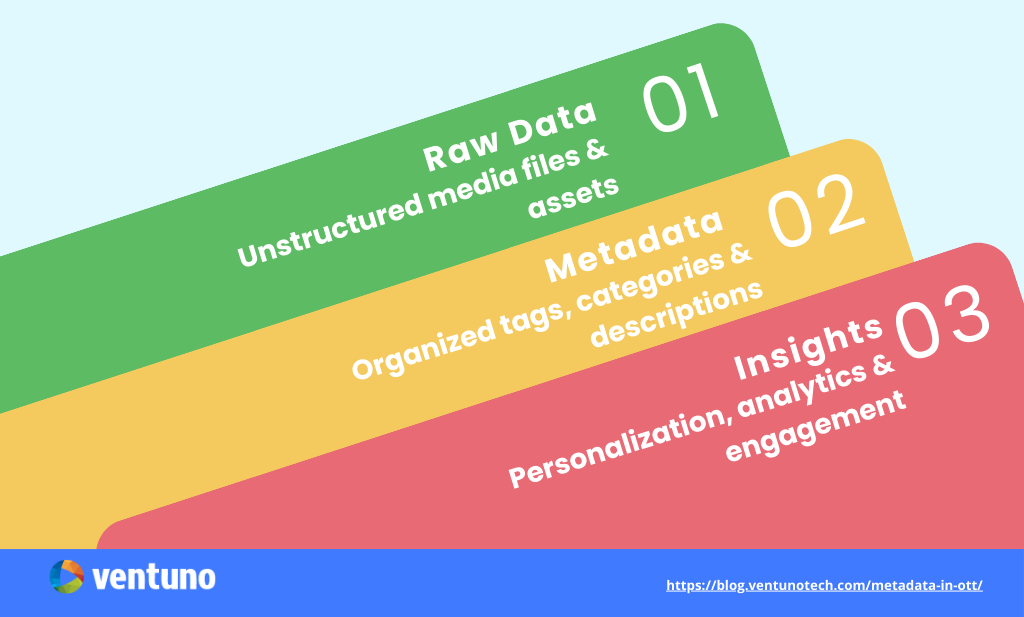
Metadata is the backbone of content organization in OTT platforms, shaping everything from searchability to personalized recommendations. But how does metadata evolve from raw data into meaningful insights? This process unfolds across three key layers
Raw Data → Metadata → Insights.
Raw Data: The Foundation
Raw data is the unprocessed information captured at the content creation stage. It includes
- Raw Video Files – Uncompressed or encoded video formats (MP4, MKV, MOV)
- Resolution & Encoding – 1080p, 4K, HDR, bitrate, codec (H.264, HEVC)
- Image Assets – Thumbnails, posters, banners
- Audio Tracks – Languages, dubbing, surround sound formats
- Subtitle & Closed Caption Files – SRT and VTT files
At this stage, the data is technical and lacks context—it needs to be structured to become usable.
Metadata: Structuring the Data
Metadata organizes raw data into meaningful categories, making content discoverable and manageable. It can be broken down into
- Title & Synopsis – Name of the show/movie and its summary
- Genre & Tags – Drama, Sci-Fi, Action, Comedy, etc.
- Cast & Crew – Actors, directors, producers
- Keywords – Helps with search and recommendations
- Hierarchy – Organized as Series → Seasons → Episodes or Movie → Director’s Cut → Behind-the-Scenes – Special editions
Insights: Driving Engagement & Personalization
Once structured metadata is in place, user interactions generate insights that help optimize recommendations and content strategy.
Key insights include
- User Clicks – What users click on from recommendations
- Search Behavior – Trending keywords, most-searched genres
- Watch History – What users watch, rewatch, or abandon
- Engagement Metrics – Completion rates, drop-off points
Metadata in OTT Example
Let’s say you are a fan of the horror-thriller series Stranger Things on Netflix and streamed the latest season of it. Each episode that you enjoyed watching is the data in itself.
Apart from the actual web series, Netflix will have a lot of other information and relevant content which is considered metadata. Metadata enables recommendations on your Netflix user profile after you complete watching the latest season of Stranger Things.
Let us see what is the supporting information available for the show Stranger Things and a particular episode of it on Netflix:
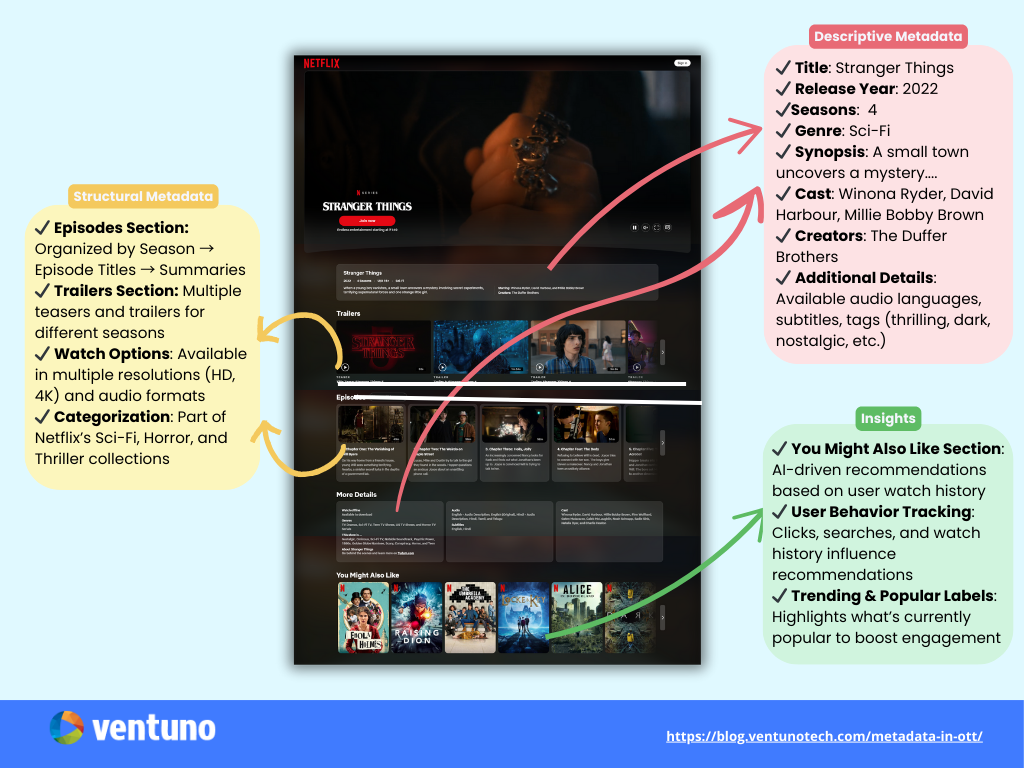
Why This Matters?
- Metadata powers content discovery, recommendations, and engagement.
- A well-structured metadata system ensures users find what they love, faster!
Types of Metadata
Different types of metadata serve different purposes, from improving search functionality to enhancing user engagement. Here are the different types of metadata used in the streaming business.
Descriptive Metadata
This metadata tells you all about your content. It includes things like the title, genre, a brief description, who’s in it, when it was released, and what language it’s in.
Structural Metadata
This kind of metadata is all about how your content is organized. Is it a full-length movie, a TV show with episodes, or even individual scenes? This metadata helps you keep everything in order.
Administrative Metadata
Think of this as the technical side of things. It includes details like how big the file is, what format it’s in, and how fast it streams (bitrate). It’s essential for keeping your content running smoothly.
Legal Metadata
This metadata is about ownership and rights. It lets you know who owns the content and what you’re allowed to do with it, ensuring you stay on the right side of the law
Contextual metadata
Contextual metadata is like knowing your audience’s environment. It provides information about where and how viewers are watching—details like their location, the type of device they’re using, and their viewing history. This information helps you personalize content recommendations and user experiences, making it more relevant to each viewer.
Usage Metadata
This metadata tracks how content is consumed. It includes the number of views, watch duration, pause and rewind points, and engagement metrics like likes and comments. Platforms use this data to refine recommendations and measure content performance.
SEO Metadata
SEO metadata helps improve search engine visibility both within the OTT platform and on external search engines. It includes keywords, meta descriptions, alt text for images, and structured data for search engines. Strong SEO metadata improves content discoverability
Monetization Metadata
This metadata defines how content is monetized. It includes details on subscription models, pay-per-view pricing, and ad placement data. This helps in optimizing revenue generation strategies.
Subtitles & Accessibility Metadata
This metadata supports inclusivity by managing subtitle files, closed captions, sign language interpretations, and audio descriptions. It ensures accessibility for a wider audience.
How Can Metadata Improve User Experience?
Metadata is not just about labeling content—it is the driving force behind an intuitive, personalized, and engaging user experience. Whether it’s recommendations, searchability, structured organization, or interactive insights, metadata plays an important role in how users consume and engage with content on streaming platforms.
Metadata shapes the user experience on OTT platforms by enhancing content discovery, organization, recommendations, and engagement. When metadata is structured and utilized effectively, it helps users navigate vast content libraries effortlessly, ensuring they find and enjoy content that aligns with their preferences.
Let’s see how
1. Organizing Content for Seamless Navigation
Metadata enables the classification and organization of movies and shows based on various factors such as
- Genre & Subgenres – Drama, Sci-Fi, Thriller, Comedy, etc.
- Maturity Ratings – Content suitable for different age groups.
- Cast & Crew Information – Easy access to actors, directors, and creators.
- Social Cause Categories – Genres like African-American cinema or LGBTQ+ representation.
OTT platforms like Netflix and Amazon Prime Video organize metadata-driven rows on the homepage, allowing first-time users to browse through curated collections without prior knowledge of specific shows. This structured approach makes content easily accessible and helps in retaining user interest.
2. Content Discovery – Finding the Right Show at the Right Time
Metadata significantly improves searchability and content discovery. Even if a show isn’t trending, metadata ensures that users can find it using relevant keywords or categories. For instance, nostalgic sitcoms like Friends or Seinfeld may not always be featured on the homepage, but metadata tags enable users to search for them easily.
Without metadata, many older or niche titles would remain buried in the content library, limiting content diversity for users.
3. Personalized Recommendations Using Metadata
One of the biggest advantages of metadata is its ability to power AI-driven recommendation engines. Streaming services like Netflix and Prime Video analyze watch history, viewing duration, genre preferences, and search patterns to suggest relevant content.
For example, if a user watches Stranger Things (a mix of horror, sci-fi, and teen drama), Netflix might recommend
- The Walking Dead (horror)
- The 100 (sci-fi, dystopian drama)
- Rick & Morty (sci-fi, animated)
Netflix even assigns a relevancy score to each recommendation, increasing the chances of users engaging with suggested content.
4. Contextual Metadata – Enhancing the Viewing Experience
Beyond search and recommendations, contextual metadata enhances the user experience by providing additional insights while watching content.
- Amazon Prime Video, through its IMDb integration, offers trivia, cast details, and scene-by-scene character names using contextual metadata.
- Live sports streaming platforms use metadata to display real-time player stats, match highlights, and scoreboards.
This added layer of metadata improves engagement by offering more than just a passive viewing experience.
5. Metadata’s Role in Long-Term User Retention
By understanding behavior patterns and adapting recommendations accordingly, metadata helps OTT platforms increase user retention and engagement. Personalized content suggestions keep users coming back, while structured organization ensures effortless content discovery.
Challenges of managing metadata for OTT platforms
Managing metadata for OTT platforms is a complex and multifaceted task, influenced by the sheer volume of content, the intricacies of metadata itself, data consistency, manual processes, and the need for advanced technology. Addressing these challenges is crucial to delivering a seamless and engaging viewer experience.
1. Volume
OTT platforms boast vast and ever-expanding content libraries. Keeping track of and managing metadata for each piece of content can be a daunting task if you do not have a comprehensive video CMS in place.
2. Complexity
Metadata is not one-size-fits-all; it’s intricate and multi-dimensional. Ensuring that every piece of content has complete, accurate, and consistent metadata can be a complex endeavor. Content can have various attributes, from actors and genres to subtitles and viewing resolutions.
3. Consistency
Metadata often flows in from various sources, contributing to data inconsistencies. This diversity in data collection methods can hinder the effective use of metadata to enhance the user experience and monitor viewer engagement. Ensuring uniformity across all data points is necessary to overcome this challenge.
4. Manual Processes
Many OTT platforms still rely on manual processes for managing metadata, which can be incredibly time-consuming and inefficient. Manually inputting or updating metadata for a growing library of content can lead to errors and delays.
5. Accurate Multilingual Metadata
Capturing and storing metadata accurately can become particularly challenging when dealing with content in multiple languages or complex character sets. Translating metadata while preserving its integrity can be tricky.
6. Keeping Metadata Up-to-Date
For content like news updates, sports events, and live channels that are frequently refreshed, ensuring that metadata remains current can be a constant struggle. Outdated metadata can lead to confusion among viewers.
7. Consistency Across Multiple Platforms
OTT platforms often distribute their content across various devices and platforms (smartphones, smart TVs, web browsers, etc.). Maintaining metadata consistency across all these platforms is a significant challenge, as each may have different requirements and formats.
Ventuno Metadata Management
Ventuno has features that enable you to add metadata to videos to organize, search and recommend video content. Simply fill up the metadata in the form format and viola! Your video content is easily searchable and discoverable by users.
Here’s how you can enter metadata for movies in Ventuno.
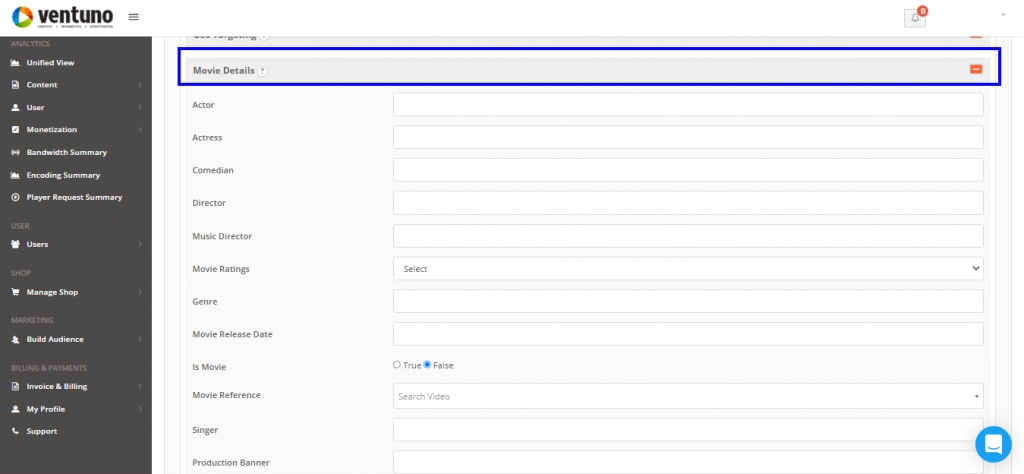
Some of the important features of the Ventuno platform are:
Organize Content
The purpose of metadata is to organize content. Organizing content in your library helps you curate your content into the right playlists, shows, and other groupings
The pre-defined tags help you organize your content at a granular level. Content can be accessed across multiple categorizations, and also appropriate content can be retrieved for a narrow look-up.
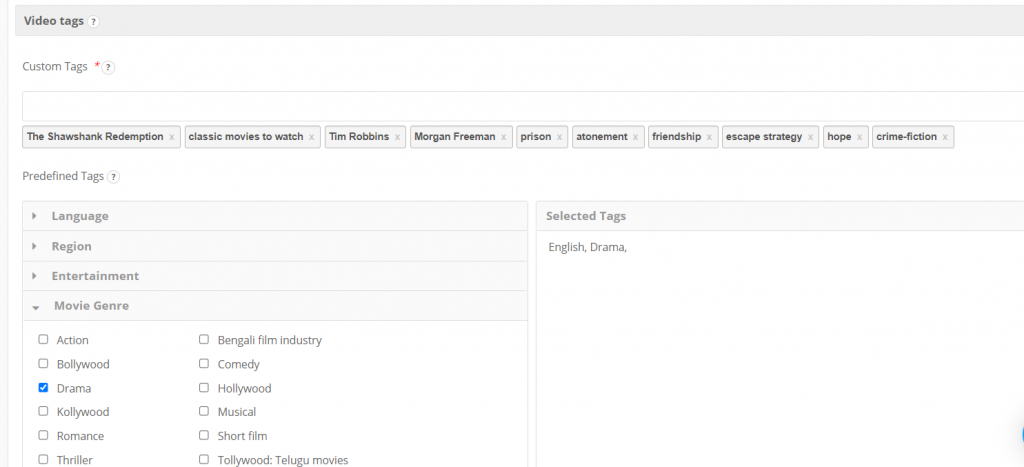
Manage Shows
Ventuno allows you to organize videos as shows and seasons and episodes, this enables the viewers to quickly look for a particular content
Search Content
Enabling your audience to look for specific content is the very purpose of organizing the content. Tags make the process of searching simplified. Simply fill in tags with search phrases for the content. Filling the right keywords in the tags section will improve the search experience for the audience.
💡 Title, tags, and video descriptions play an important role in searching and recommending content
Recommendation Section
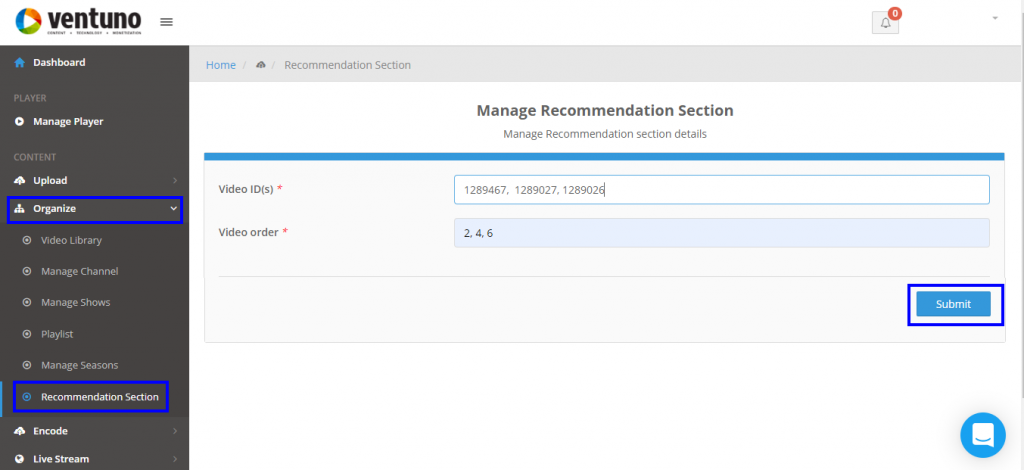
Apart from recommending content based on title and tags, Ventuno has a dedicated section to recommend specific videos across all other videos that are uploaded on the platform. All you need to do is insert the video id and then that video will be recommended across all the videos.
Best practices for managing metadata for OTT platforms
By following these best practices, you can effectively manage metadata for your OTT platform, enhancing the user experience and maximizing the value of your content.
1. Define a Metadata Strategy
Start with a clear plan. Define a metadata strategy that aligns with your business goals and audience needs. Identify the most important types of metadata for your platform and outline how you’ll use it to enhance the user experience.
2. Implement Metadata Standards
Consistency is key. Implement metadata standards across your organization to ensure uniformity. This consistency makes managing metadata easier and allows you to leverage it effectively.
3. Invest in Training and Education
Knowledge is power. Train your staff in effective metadata management. Help them understand the significance of metadata and how it contributes to improving the user experience. Well-trained teams can minimize errors and inconsistencies in metadata handling.
4. Capture Metadata at the Source
Start right. Ensure that metadata is captured accurately and consistently at its source – be it your content partner, individual creator, or a media house. This initial step sets the foundation for reliable metadata throughout its lifecycle.
5. Use a Variety of Data Sources
Cast a wide net. Collect metadata from various sources, including content creators, distributors, and standard sources like IMDb. This diversity provides a comprehensive view of your content and audience.
6. Consolidate Isolated Metadata in a Central Layer
Many platforms store metadata in scattered silos, leading to inconsistencies and inefficiencies. A centralized metadata repository (or metadata management system) ensures that content-related metadata is stored, updated, and retrieved from a single source of truth.
7. Clean and Enrich Your Metadata
Regular upkeep is essential. Periodically clean and enrich your metadata to keep it accurate and up-to-date. You can do this manually or leverage machine learning and AI for efficiency.
8. Make Your Metadata Accessible
Share the wealth. Ensure that your metadata is accessible to users and stakeholders. Make it accessible for search engines, and users for easy access to the valuable library that you have created.
FAQ
Metadata is structured information that describes video content, including titles, genres, cast, subtitles, descriptions, thumbnails, licensing details, and user engagement data.
For an OTT platform, metadata is essential for:
Content discovery – Enables users to find videos through search, recommendations, and filters.
SEO & discoverability – Optimizes content for both internal search and external search engines.
User experience – Organizes content into structured categories, playlists, and personalized recommendations.
Monetization – Helps optimize AVOD, SVOD, and TVOD strategies by categorizing premium and ad-supported content.
1. Make it easier for users to find the content they want by providing relevant search results and recommendations.
2. Provide users with more information about the content they are watching, such as biographies of the cast and crew, behind-the-scenes photos and videos, and related content.
3. Personalize the user experience by recommending content that is likely to be of interest to each individual user.
4. Track viewer engagement and trends to help OTT platforms improve their content offerings and marketing strategies.
OTT platforms use various types of metadata to enhance content organization, user experience, and monetization strategies:
Descriptive Metadata – Titles, genres, cast, keywords, plot summaries.
Structural Metadata – Defines content relationships (e.g., series → seasons → episodes).
Administrative Metadata – File format, resolution, encoding details, storage locations.
Legal Metadata – Copyright details, licensing agreements, regional restrictions.
Contextual Metadata – Viewer location, device type, session length, past watch history.
Usage Metadata – Engagement metrics like views, watch time, comments, likes.
SEO Metadata – Keywords, meta descriptions, alt text for images, structured data for search engines.
Monetization Metadata – Defines ad placement, paywall settings, and revenue models.
Search: Metadata is used to power search results in OTT platforms. This allows users to easily find the content they want by searching for titles, genres, actors, directors, and other keywords.
Recommendations: Metadata is used to generate personalized recommendations for users. This helps users to discover new content that they may be interested in.
Navigation: Metadata can be used to organize content in OTT platforms. This makes it easier for users to find the content they want, especially in large content libraries.
Information: Metadata can be used to provide users with more information about the content they are watching. This can include things like biographies of the cast and crew, behind-the-scenes photos and videos, and related content.
One of the latest trends in using metadata in OTT platforms is the use of machine learning and artificial intelligence to automate the process of cleaning and enriching metadata. This can help OTT platforms to keep their metadata accurate and up-to-date more easily.
Another trend is the use of metadata to personalize the user experience more granularly. For example, OTT platforms can use metadata to recommend content based on the user’s viewing history, mood, and other factors.
Wrapping up
Recommendation, relevancy, cataloging, content discovery, user engagement & retention are some of the many reasons why OTT metadata is so important for live streaming, VoD and OTT platforms, and businesses.
If you are an OTT platform provider, ensure that managing metadata is an integral part of your business strategy. As an additional set of information about video content, metadata in OTT makes the user’s journey of browsing through the content gallery seamless.
Looking to launch your streaming app?

